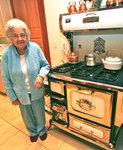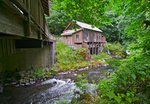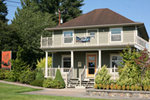



In the early 1970s Margaret Colf Hepola got a chance to again look at her precious locust trees. But this viewing was less than ideal and only served to reinforce her sense of loss after the Merwin Dam had submerged the trees, her home, and hundreds of surrounding acres of the Lewis River Valley.
First, she had word that they were still standing from people who had been searching Lake Merwin by small submarine. They were looking for remains or evidence in the D. B. Cooper case. Cooper had hijacked a Boeing 727 aircraft in the airspace between Seattle and Portland on Nov. 24, 1971. With a reported $200,000 in ransom, Cooper parachuted to an uncertain fate.
The report from those searching the lake was that the trees were still standing tall. Then, a year later she was on a boat tour of the lake and saw them on a fish finder.
“They were still there, reaching for the sky, but were never to see the sky again,” Margaret said sadly.
After the creation of the dam and the flooding of their land, Margaret, her parents Albert and Irene Haller and her brothers and sister moved a few miles away to continue to raise the family in a rural, farm setting, instilling their love of the land and its bounties in all of the children.
During the Great Depression, Colf Hepola remembers that her mother, who had a sixth-grade education, earned money by teaching local women how to sew clothes from potato sacks.
“She taught us a valuable lesson,” she said. “We had to work to get food.”
Walter Colf owned a little country store and met Margaret at a public dance.
“In those days that’s how you met people,’’ Margaret said. “Kind of old fashioned, but they were fun and you got to meet people your own age. Anyway, I’d worked in a Finnish Co-Op store for four years and I think that’s why he married me – so I could help him with the store.”
They were married for 21 years and brought five children into the world.
“He said that I talked a lot and once claimed that I could talk to a telephone pole and it would answer me,’’ Margaret said. “We had three daughters: Sharon, Mary, and Nancy; and two boys: Bob and Dick. One daughter is a farmer, the other a nurse, and the third is a music teacher. But they are all kind of shy.’’
Son Dick is now retired but was the Executive Vice President of Kiewit – a construction, engineering and mining services company that he’d worked with for 40 years, and brother Bob is President of Colf Landscape Construction in Vancouver.
Their children took jobs as young as 10 in local berry fields, and used earnings to buy their own clothes. In college, Bob remembers waking up at 3 a.m. to work as a logger before class, earning his own way through Washington State University.
Nine years after they were married, Walter developed a brain tumor and underwent major surgery, and although he had occasional seizures, he went right back to working the forests. Margaret worked alongside him many days, cruising the timber and figuring out footage of trees they wanted to harvest while her mother took care of the young children at home.
“That’s when I became a ‘whistle punk,’’’ she said. When asked what a whistle punk was she explained, “The whistle punk’s job was to sound a whistle as a signal to the yarder operator controlling the movement of logs and act as a safety lookout, and a good whistle punk had to be alert and think fast as the safety of the others depended on them.”
She continued, “I really love logging. When I started at the Amboy Museum, a man wondered why I was so interested in restoring old logging machines – but it hurt me to fall a tree, (I) always felt it had something to tell.’’
Working with Walter and the other lumbermen, Margaret developed a life-long love of timber and the proper stewardship of the forest.
“People said I’d rather talk to timbermen than my lady friends,” she says smiling. “I guess they were right.”
Talking about Walter she reminisced, “Many people would have just retired or sat in a chair and taken compensation, but Walter kept on working for another 12 years, climbing and felling trees and running our sawmill.” He was killed in a freak timber-felling accident when a tree fell and hit his head, leaving Margaret, then 44, a single mother with two children in college and three in grade school.
Her second husband, Ed Hepola was also in the lumber industry, and in the 14th year of their marriage he dropped dead of a heart attack when he was surveying timber in the deep snow near Lake Merrill.
“It’s ironic and sad that both of my husbands died with a tin hat on their head, and a power saw in their hands,” she shares.
Margaret actually began her life-long crusade to save old buildings when she started volunteering at the age of 20, helping guide and take part in projects for the Hulda Klager Lilac Gardens, the Cedar Creek Grist Mill, the Clark County Genealogical Society, the Cowlitz County Historical Museum, the Clark County Historical Society and the Amboy Historical Museum. However, one of her favorites was helping to open the La Center Library after it was converted from a hospital.
For Margaret, this would be a labor of love. Her mother worked at the hospital as a teenager, and the last of three doctors, who practiced there, Dr. Carl J. Hoffman, was the attending physician at her own birth in 1917. The memory of Dr. Hoffman, one of Clark County’s last “saddle-bag” doctors, inspired her to take on the project. But Margaret had always had a vision to bring a much-needed library to La Center. This was her chance.
“When I heard that they were going to remove the old hospital in La Center, the fire department had it ready to tear down, I told the other owners – ‘you’re not going to do that,’” she said.
Margaret then enlisted the aid of her son Bob, owner of Colf Construction, who shares his mother’s respect for history and who was one of the local businessmen involved in the property’s purchase. The Colf Family Foundation provided the primary financial backing for the project, with significant contributions of time, energy, physical resources, and funds from throughout the community.
The Foundation donated land next to La Center City Park; a short distance from the original site at East Fourth and Cedar in downtown La Center. Colf Construction prepared a foundation in advance of the move and made temporary modifications to the building for better mobility. Portions of the roof in need of repair were removed, as was the back porch.
Everything of historical, aesthetic, and monetary value from the old building was saved to be re-used, including oak flooring, spindles and railings from the stairs, along with much of the old wood, which was refinished and used as window trim.
The restoration is as historically accurate as possible with some modifications needed to prepare the building for its new life as a modern library. An elevator was installed, as was an underground geothermal heating and cooling system, a steel fire escape, a computer network, and a professionally landscaped exterior plaza, which incorporated bricks that were sold at fundraising events.
Her many accomplishments have earned her distinctions such as a 2002 Woman of Achievement Award, honors as the First Citizen of Woodland, La Center and Amboy, as well as the 2006 Margaret Colf Hepola Heritage Award – which the Clark County Historical Society named in honor of her significant contributions to preserving history.
The Washington State House of Representatives even recognized her as having “life works of a true humanitarian.” In addition to her passion for historic preservation, she also has a knack for philanthropy. Over the years she has supported her many projects with gifts of considerable financial support that have ultimately benefitted parks, libraries, museums and the region at large.
Margaret Colf Hepola is considered by many as truly one of Clark County’s visionaries, a fragile but fierce protector of things old and treasured, a devoted mother, and an example for all.
“I feel fortunate that our family can give, but when we go into something, we want to take part in it too,” she said. “It’s wonderful for people to give money, but these projects take volunteers to make the money worthwhile. They’re the salt of the Earth.”